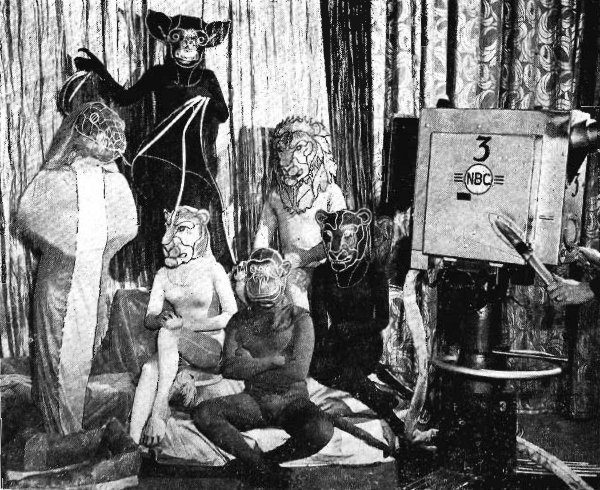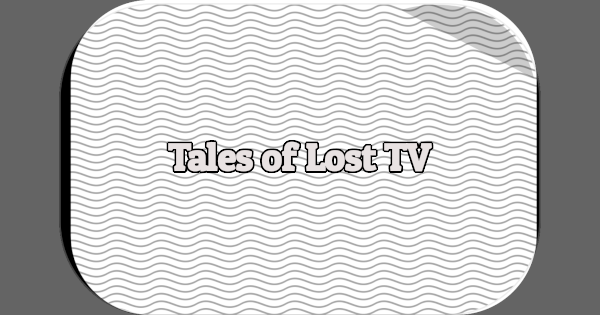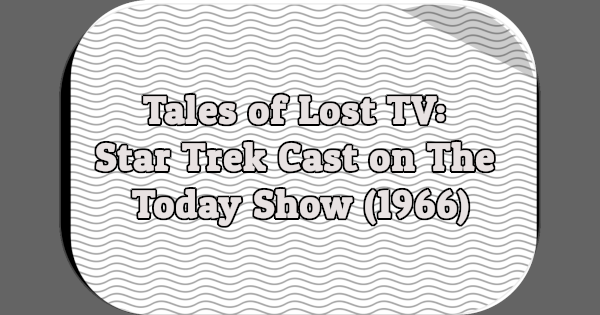Tales of Lost TV is a monthly column in which I examine a particular TV program or TV series either known or believed to be lost forever. The amount of lost TV is truly staggering–aside from a handful of exceptions everything broadcast prior to 1948 no longer exists. That doesn’t mean it all has to be forgotten.
An Allegorical Fantasy
WNBT aired this fantasy program in New York City on Sunday, November 10th, 1946 as a pre-Armistice Day special. Adapted from Neil Grant’s 1934 one-act play of the same name, it depicted a future world devastated by war. Only animals survive. The cast wore luminescent wire masks and costumes. Among the animals seen were a horse, a snake, a dog, a panther, a lion, a bat, and a monkey.

Copyright 1946 NBC/Frederick Kugel Company
The wire masks, Radio Daily explained, allowed viewers to see the faces as well as the animals. NBC makeup artist Dick Smith designed the masks, working with the costume designer known only as Elwell.
The cast included Eva Marie Saint, Fay Marlowe, William Post, Jr., Evelyn Peterson, Philip Tonge, Kendall Clark, Mary Wilsey, Ann Irish, John McQuade, Vaughn Taylor, Arthur Hunnicutt, and Walter Coy. According to some sources, Fred Coe directed and produced “The Last War.” Other sources indicate Warren Wade served as director and executive producer.
The American Radio Archives has a copy of the script for “The Last War” in its Broadcasting Collection. According to a catalog, writing credit (“adaptation”) for the script is given to Howard Cordery.
Not Quite Anti-War
According to a review in Television magazine, “The Last War” opened with mankind being crossed off the evolutionary tree. An angel desceneds to Earth to retrieve the last surviving man. Film footage of war and destruction then played, revealing the fate of humanity.
The review continued:
Through allegory, and philosophical discussion the play established its final point which was that man had failed in his mortal life. Final studio scene faded into a filmed quotation from Charles Darwin as the narrator read the words.
It seemed that the play was really not an anti-war play after all … but a one-acter proving that life was really unimportant, if one believed in the soul’s immortality. Despite these philosophical conclusions with which we will not argue, the presentation with its well-timed usage of excellent film clips and unique costuming, background, stirring music, and fine acting provided televiewers with a highly diverting and stimulating drama.
Variety also published a review but I don’t have access to it.
“The Last War” started at either 8:30PM or 8:45PM ET and lasted 45 minutes. It may have aired as an installment of NBC Television Theatre. The irregularly-scheduled series of live dramas ran from 1945 to 1947, first on WNBT and later on the nascent NBC network.
Surviving Material
“The Last War” aired live prior to the introduction of the kinescope recording process, so it is considered lost. However, some material relating to the program does survive. In addition to a script held by the American Radio Archives, at least four behind-the-scenes photographs of the cast in their masks and costumes exist. The New York Times published two photographs in its November 10th, 1946 edition.
Dick Smith briefly talks about “The Last War” in his 1996 interview with the Archive of American Television. He identifies people in three photographs, including the two published in The New York Times. A third is a close-up of Eva Marie Saint in her panther costume, a full version of which can be found at Dick Smith’s Special FX Makeup Training website.
A fourth photograph, which I’ve reproduced above, appeared in the December 1946 issue of Television magazine.
References:
“Anti-War Script Set For NBC Tele Program.” Radio Daily. 31 Oct. 1946: 3.
Berard, Jeanette M. and Klaudia Englund. Television Series and Specials Scripts, 1946-1992: A Catalog of the American Radio Archives Collection. Jefferson, NC: McFarland & Company, Inc., Publishers, 2009: Page 379.
“‘The Last War’ on Television.” New York Times. 10 Nov. 1946: X9.
“Painting a Moral. Billboard. 16 Nov. 1946: 10.
“Programming.” Television. Dec. 1946: 35; 39.
Terrace, Vincent. Television Specials: 5,336 Entertainment Programs, 1936-2012. 2nd ed., Jefferson, NC: McFarland & Company, Inc., Publishers, 2009: Page 226.
Does “The Last War” intrigue you? It sure intrigues me. Hit the comments with your thoughts.






This was similar in theme to the Christmas cartoon Peace On Earth (1939) and its remake, Good Will To Men (1955). These dealt with mankind wiping itself out in war, and then the animals took over. In Peace On Earth, it was two young squirrels about the phrase “Good Will To Men” and then asked, “What are men?” This was in the backdrop of the beginning of World War II, and conventional weapons from that time wiped mankind out. Good Will To Men was with a church choir of mice asking their preacher the same thing. The Cold War and the Atomic Age were starting and this time it was the new nuclear bombs that would wipe man out.
It sounds like NBC Television Theater was a catch-all title for various plays since it ran at odd times. PBS’s Great Performances would probably be a modern version of the same thing.
I’m sure there was plenty of anti-war sentiment during WWII that was suppressed during the war that came out after it ended. But there would also have been a collective mourning after the war since so many families were impacted by loss. Even if a family didn’t loose someone in the war, they may have had friends or neighbors who died. There was a lot of sadness which makes the happiness of 50s TV somewhat ironic.
I’m betting that post war prosperity, the Cold War, and the rise of HUAC’s persecution of ‘Reds’ and anybody wanting to see a peaceful world were factors in 50’s TV being like that.